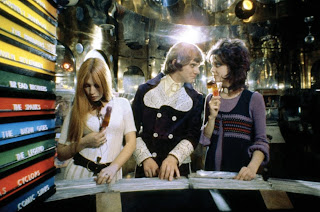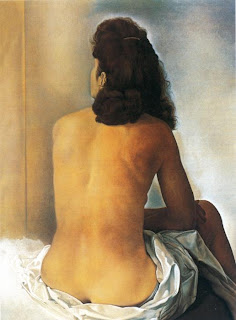 by Drew Martin
by Drew MartinDuring one introverted spell in college, I shut my door to the world for a few days and watched a stack of movies. It sounds harmless, but I usually do not do unhealthy shut-in things like that. The only film I remember from that stretch was Fahrenheit 451. What I recall, is not so much watching it but thinking what seeing it versus reading it meant. In this case, I read the book and then saw the movie.
There exists the common exchange,
"Have you read ___________"
"No, but I saw the movie."
In most cases, this answer is a bit of an embarrassment because it is an admission to a diluted and commercial experience. Surrendering to the cinematic version means less time with the subject and a shallow understanding of the characters. The cognitive challenge of reading a book requires an imaginative mind, which is needed to comprehend things that come too easily in film. The experience of seeing the film after reading the book may also be spoiled by certain actors and limitations of the visual medium.
 There are some cases, where the acting is so good, that the film gains a certain level of credit: Gregory Peck in To Kill a Mockingbird.
There are some cases, where the acting is so good, that the film gains a certain level of credit: Gregory Peck in To Kill a Mockingbird.Even if the acting is so-so, a director's faithfulness to the book and perhaps other factors such as shooting on location, make the movie a wonderful follow-up to the text: Sean Penn's Into the Wild.
And then there are the supreme directors who make films that not only get under the skin of the authors and characters, but also add something with their own genius and vision: Stanley Kubrick's 2001: A Space Odyssey and A Clockwork Orange.
Someone interested in media would ask the same standard question I asked regarding this book/movie relationship...What is the difference between reading a book and watching the movie version and what are the affects of each? The differences can be simply technical and the affects may be profound.
 Fahrenheit 451 compounds the issues by making the differences central to the plot. Seeing it on a screen means that you are already in that futuristic world, where the only purpose of the fire department is to burn books (at the temperature of the title) since the houses in the future are all fire-proof. Reading the book makes you one of the underground collective who commit books to memory.
Fahrenheit 451 compounds the issues by making the differences central to the plot. Seeing it on a screen means that you are already in that futuristic world, where the only purpose of the fire department is to burn books (at the temperature of the title) since the houses in the future are all fire-proof. Reading the book makes you one of the underground collective who commit books to memory.I think about this kind of thing a lot but every once in a while the gravity of it makes the sky seem like it is falling.
I knew one of my favorite Village-area bookstores, the 20-year-standing Biography Bookshop had been pushed down Bleecker Street to a new location, which I have been supporting, but I did not know (until a couple weeks ago) that it was replaced by Bookmarc by Marc Jacobs. A friend had told me about the new tenant so I went by to see what they had to offer. I was actually very open-minded but once inside, I had a very uneasy feeling. Just as Jacobs would not like the fashion vision of a bookworm, his vision of a bookstore is quite pathetic.
My first impression is that it is a bookstore with a lot of accessories for sale, which would make a non-literate model feel comfortable and good about herself or himself. The artsy books are more like hard-covered fashion magazines, only with less text and, for the most part are more on the profane/smutty side.
 My instinct, which I followed, was to recuperate in The Strand's 18 miles of books and purchase something substantial to fill the void. I bought four books including Boethius' 6th century AD The Consolation of Philosophy. On my return, I stopped back into Bookmarc to see if I was being unfair...but the feeling returned and the too-cool-for-school shoppers were contemplating the "books" and other merchandise with a similar lack of discrepancy: as equal "things" to buy.
My instinct, which I followed, was to recuperate in The Strand's 18 miles of books and purchase something substantial to fill the void. I bought four books including Boethius' 6th century AD The Consolation of Philosophy. On my return, I stopped back into Bookmarc to see if I was being unfair...but the feeling returned and the too-cool-for-school shoppers were contemplating the "books" and other merchandise with a similar lack of discrepancy: as equal "things" to buy.My shock of such things is short lived but I ponder the long-term meaning of trends. As books (the written ones) are moving to Kindles and NOOKs and the book format is absorbing more personal art and photographic experiences, especially with limited-edition, self-publishing sites such as Blurb...we may simiply be witnessing the evolution of the word "book". I recently wrote about such a transition with the meaning of red in Red Square. It is not out of the question that a book will simply cease to be a thing we read any more the same way "magazine" is no longer a place we stock goods and gunpowder.



















 If I were to ask you if the arts and the subway system have in anything in common, you would probably think of some connection (no pun intended). Perhaps the musicians and other buskers would come to mind; performing for the waiting and hurried commuters; or the less-but-more-visible
If I were to ask you if the arts and the subway system have in anything in common, you would probably think of some connection (no pun intended). Perhaps the musicians and other buskers would come to mind; performing for the waiting and hurried commuters; or the less-but-more-visible 











